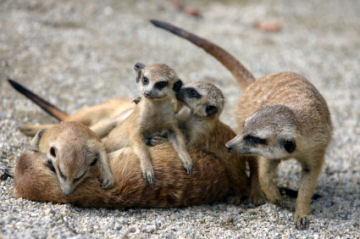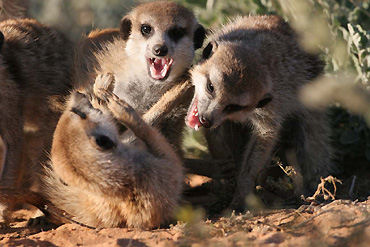Tim Clutton-Brock has suddenly said, for reasons not at all clear to me, “Hard-boiled egg.” Perhaps it’s best to ignore this. So, I ask him again in our phone conversation what he would pick as the highlights of his past 13 years of directing a field study of meerkats in the Kalahari Desert. Meerkats, a type of mongoose, cluster in family groups and share the job of raising the top female’s pups. Clutton-Brock and his colleagues have published reports on meerkat behaviors ranging from altruism to infanticide. But it turns out that the first highlight that he wishes to discuss actually is a hard-cooked egg.




When Clutton-Brock, a behavioral ecologist at the University of Cambridge in England, was setting up the desert study, most meerkats ran away if people got within 300 meters. He and his colleagues “tried everything,” he says, to find treats that would encourage the animals to tolerate people so that the team could collect data.
“We tried locusts,” says Clutton-Brock. “We tried obvious things that other sensible mongooses eat, like peanuts and peanut butter and minced chicken, various sorts of insectivores’ [packaged] diets, mealworms, and God knows. They wouldn’t eat it at all.”
Because meerkats occasionally eat wild-bird eggs, the researchers offered them chicken eggs. But the animals weren’t interested. However, when the meerkats came back to hang around their burrow entrance in the evening after foraging, some egg contents earlier spilled on the ground had been cooked by the day’s heat. Several youngsters sniffed at it, tasted it, and finally ate it.
“It hadn’t occurred to us that they would actually rather like their eggs cooked,” says Clutton-Brock.
After that breakthrough, judicious use of hard-boiled egg crumbs enabled the researchers and collaborators from other institutions to collect the most detailed data yet on free-living meerkats. The animals’ subsequent tolerance of people has benefited the world of entertainment as well as science. It has given film crews access to intimate views of animal life.
Several projects are in the works, and the television series Meerkat Manor, already a hit, follows the fortunes of one group of meerkats at Clutton-Brock’s study site. Despite their species, the characters’ adventures with illicit pregnancies, wayward children, and neighborhood rivalries resonate with themes in typical television dramas.
Meerkat close-ups show both the charms of a highly cooperative life and the trade-offs that it requires. To the scientists, the dramatic behaviors have broad implications for the study of social behavior and evolution. But they also make for some great soap opera.
One for all
Meerkats’ cooperative side, easy for people to like, is also easy to see. The animals live in groups of 3 to 50 animals, mostly close family members with about equal numbers of males and females. They defend territories of 2 to 10 square kilometers. The animals spend the night together in one of the burrows in their territory. By day, they rove through the scrubby vegetation looking for scorpions, lizards, and other small animals.
As a meerkat group searches the ground, one member typically stands guard. Depending on how robust the volunteer is and how fast the group moves, guard duty can last half a minute to half an hour. When the guard leaves to forage or the group moves on, another meerkat takes over the watch.
The sentinel clambers up on whatever’s available for the best view, be it a tree snag or the hat of a note-taking scientist. The guard stands on its hind legs as stably as a person does and watches intently, turning its head this way and that, and twitching its nose. Its paws dangle by its side or cross in front of its body, like someone waiting politely, perhaps in white gloves.
The sentinel provides “a more advanced antipredator system than everybody looking up now and then,” says behavioral ecologist Andrew Young, also of Cambridge. Marta Manser, now at the University of Zurich, has investigated the guard’s role by recording the soft little chirps that it makes—on average, 10 every minute. When a meerkat heard the recording, it spent more time head-down, searching and eating, than it did in the absence of the calls. Silence made the forager look up more often and eat less.
Another social nicety shows up when the group has young pups. Until the kids are old enough to tag along with foragers, one of the older meerkats stays home and babysits. For the first 2 or 3 weeks of pups’ lives, the babysitter spends the day underground with the newborns. When the pups are old enough to clamber out of the burrow, the nanny keeps watch near the burrow mouth. Youngsters tumble over each other in wrestling matches and chases and then nap, often cuddled against the babysitter. Should a youngster stray too far, the nanny picks it up by the scruff of the neck and carries it back to safety.
Nannies have to stay alert for attacking birds or other predators and for rival groups of meerkats that occasionally invade and kill pups. “One of the most spectacular things a babysitter will do is defend against a raid,” says Young.
Faced with a raid, a babysitter sends the pups into the burrow and takes a stand in front of them. Because meerkat tunnels are narrow enough to force raiders to enter one at a time, the baby-sitter has a chance of holding off even a big party, at least for a while. However, the raiders soon start digging around the main entrance, and “get very excited,” says Young. If they widen the tunnel enough, they can gang up on the babysitter or even reach the pups directly. When they do, “it’s gruesome,” says Young.
Yet even excited meerkats need time to excavate. Young says that he has watched a babysitter fight off attackers for more than 2 hours before the rest of the family came home and chased away the intruders.
A more mundane, but serious, threat to the caregiver is weight loss, says Young. The other adults don’t bring home anything for the babysitter to eat. Thanks to the magic of hard-boiled eggs, the researchers coaxed meerkats onto a scale at the beginning and end of several days. During a 24-hour period that included a daylight shift with the kids, a meerkat typically lost 1.3 percent of its body weight, the team reports. An animal that hunted all day gained 1.9 percent of its body weight during the same period.
Although the colony’s most dominant male and female parent 80 percent of the pups, “one of the most striking things is that dominant individuals hardly ever babysit,” says Young.
He speculates that the mother doesn’t baby-sit much because she needs to eat to keep providing milk. She becomes fertile again soon after giving birth, which may explain the dominant male’s behavior. “The last thing he wants to be doing is sitting at the burrow with the pups, when she’s out there fertile and available,” says Young.
So, it’s the subordinate adults, with teenage backup now and then, that do most of the child minding. Both females and males babysit, but the females do it more often.
As far as the researchers can tell, meerkat babysitters volunteer for the job. An animal, apparently spontaneously, hangs back at the burrow as the rest of the group sets off. There’s none of the snarling and nipping that meerkats use for coercion. Rarely does the same meerkat volunteer two days in a row, and younger and underweight animals are less likely to babysit than are more-robust animals.
Hormones may have something to do with the sitter’s self-selection, says Anne Carlson, based in Missoula, Mont., who works for the Tropical Biology Association, headquartered in Cambridge, England. She investigated hormones known in several species to vary with care giving to youngsters. For example, scrub jays that are feeding younger siblings tend to have blood higher than normal in prolactin.
Carlson and her colleagues found that a male meerkat about to spend the day with the kids has higher blood prolactin concentrations than does a similar male in the same group preparing to go off on a day’s foraging. After a day at the burrow, though, the babysitter’s prolactin concentration has gone down, the team reported in the June 2006 Hormones and Behavior.
Clutton-Brock considers an evolutionary question: What drives a meerkat to go hungry and risk death in battle for somebody else’s pups? The standard answer to such a riddle invokes the power of kinship, he says, but the meerkat data are leading him elsewhere.
Among meerkats, he says, tighter kinship bonds don’t match up with extra babysitting or other effort on behalf of the group. So, he and his colleagues began thinking about an additional factor: the importance of group size. A small group may not field a full complement of sentinels or babysitters, and rivals may snatch territory, kill pups, or even take over a comfortable burrow. “As group size declines, life goes to hell in a hurry,” Clutton-Brock says. “It’s in everybody’s interest to maintain group size.”
Dark side
In some ways, meerkats look as if they have “the ultimate family life—one for all and all for one,” says Clutton-Brock. But that tight intimacy leads to extremes in family feuds.
Young and his collaborators have been studying dominant female meerkats’ tendency to violence during the last month of a pregnancy. The supermoms attack subordinate, mature females in the group—even their own daughters—seemingly without cause. The dominant female often wounds subordinates around the base of the tail. Eventually, supermom harries the subordinate out of the group. However, after the dominant animal gives birth, the exile often returns home.
However “bizarre,” to use Young’s word, such behavior might seem at first glance, the researchers have proposed an explanation. If the stress of eviction reduces the chances of a subordinate getting pregnant, aggressive behavior would increase the chances that the dominant meerkat would bear the only pups in the group.
In the Aug. 8, 2006 Proceedings of the National Academy of Sciences, the team reported an analysis of observations of banished females. Those meerkats were much less likely to conceive when they encountered a male during exile than they were while living with a group, and they were more prone to abortions than were subordinates in their group. Blood concentrations of stress-related hormones were unusually high in the outcasts, and tests showed that their pituitary glands did produce the surge of hormones needed for ovulation. Young suggests that the work provides some of the strongest evidence yet that dominants can monopolize reproduction by stressing out their underlings.
If harassment doesn’t keep her colony mates from getting pregnant, the top female meerkat can always kill the subordinate’s pups. Never mind that many of them are her grandchildren.
Meerkat infanticide is difficult to study because most of it probably happens underground, says Young. He and Clutton-Brock combed through records that they’d compiled over years and found only 13 cases of a female meerkat carrying one or more pups out of the burrow and killing them. “Often, she eats them,” says Clutton-Brock.
In seven of those cases, the dominant female was the killer, but in the other six, the killer was a subordinate. On two startling occasions, a subordinate killed the dominant’s pups, Young and Clutton-Brock reported in the Sept. 22, 2006 Biology Letters.
The big motivator was pregnancy. In 12 of the 13 cases, the observers knew that the killer female was pregnant.
Another analysis confirmed the violent tendencies of pregnant subordinates. In looking at records of 248 litters, the researchers found that pups faced half the normal chance of surviving their first 4 days if any of the subordinate females was pregnant.
In the logic of meerkat survival, pup killing makes sense, the researchers say. When youngsters first venture out on a group-foraging trip, they’re such inept hunters that they depend on handouts from the older meerkats. As the number of pups rises, the older foragers catch and distribute more prey, but not enough to compensate fully for the extra pups. So, more pups result in less food for each. An infanticidal mom improves the odds of her offspring getting a square meal.
Although female meerkats have this pup-killing streak, Young notes that, unlike lions, the males don’t kill the offspring of other males. Male meerkats commandeer groups now and then, driving out the resident males and taking over their family roles. As the usurpers settle in, though, they don’t typically attack pups of the previous dads. The new arrivals even take a turn feeding the youngsters during foraging. The researchers note that killing pups doesn’t trigger fertility in female meerkats as a cub’s death does in lionesses.
The evolutionary force of sexual selection bears down more intensely on female meerkats than it does on males, Clutton-Brock and his colleagues argue in the Dec. 21/28, 2006 Nature. In the fight to reach the top spot in the group, female meerkats look forward to the bigger prize.
A supermom can dominate a colony for a decade if she’s fit, tough, and smart, and top females average 17 pups during their tenure. Males tend not to hold the top spot for as long, and they father only 9 pups, on average.
Throughout their lives, the females show more aggression than the males do. For example, females start more of the clashes in a group than males do, and females are also more often on the receiving end of aggression. And as pups play together as they grow up, females win more of the tussles than males do.
Such tough gals may not be everybody’s ideal moms. Yet they’re invaluable to researchers studying the forces that underlie such matters as infanticide.
Clutton-Brock says that he watches with interest to see how filmmakers attracted by the animals’ charisma handle such shocks to human sensibilities. Meerkat Manor, he says, has been “prepared to tell the hard side, the down side, the dark side, as well as the cute side and the up side. I salute that.”
More projects are in the works that will face the same challenge. “How meerkats are presented,” says Clutton-Brock, “is an interesting test case in whether we are happy to allow animals to be animals.”





